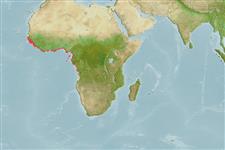Teleostei (teleosts) >
Anguilliformes (Eels and morays) >
Ophichthidae (Snake eels) > Ophichthinae
Etymology: Dalophis: Greek, dalos, ou = torch, burning piece of wood + Greek, ophis = serpent (Ref. 45335).
More on author: Bleeker.
Environment: milieu / climate zone / depth range / distribution range
Ecology
Marine; brackish; benthopelagic. Tropical
Eastern Atlantic: Liberia to Congo. Reported from the Casamance and Gambia River (Ref. 28587).
Size / Weight / Age
Maturity: Lm ? range ? - ? cm
Max length : 53.5 cm TL male/unsexed; (Ref. 4455)
Dorsal spines (total): 0; Dorsal soft rays (total): 0; Anal spines: 0; Anal soft rays: 0. Very similar to D. boulengeri. Dorsal origin very near behind gill slits (predorsal length 7.2-9.8% LT). Lateral line pores 73-80 before anus. Vertebrae: 184-191. Brown olive dorsal, whitish yellow ventral.
Burrows in sand or mud in shallow water near estuaries and in rivers (Ref. 4455).
Life cycle and mating behavior
Maturity | Reproduction | Spawning | Eggs | Fecundity | Larvae
Bauchot, M.-L., 1990. Ophichthyidae. p. 92-94. In C. Lévêque, D. Paugy and G. G. Teugels (eds.) Faune des poissons d'eaux douces et saumâtres de l'Afrique de l'Ouest. tome 1. Faune Trop. 28. (Ref. 2846)
IUCN Red List Status (Ref. 130435: Version 2024-1)
Threat to humans
Harmless
Human uses
Tools
Special reports
Download XML
Internet sources
Estimates based on models
Preferred temperature (Ref.
123201): 23.7 - 28, mean 26.7 °C (based on 66 cells).
Phylogenetic diversity index (Ref.
82804): PD
50 = 0.5312 [Uniqueness, from 0.5 = low to 2.0 = high].
Bayesian length-weight: a=0.00091 (0.00039 - 0.00215), b=2.99 (2.79 - 3.19), in cm total length, based on LWR estimates for this (Sub)family-body shape (Ref.
93245).
Trophic level (Ref.
69278): 3.8 ±0.6 se; based on size and trophs of closest relatives
Resilience (Ref.
120179): Medium, minimum population doubling time 1.4 - 4.4 years (Preliminary K or Fecundity.).
Fishing Vulnerability (Ref.
59153): Moderate vulnerability (41 of 100).
